The residential and commercial building boom we’ve seen in Manhattan shows no signs of letting up. But to build healthy neighborhoods, what we build matters. Building healthy, sustainable neighborhoods requires a process that puts what the community needs in the spotlight, and gets people talking to each other.
Make no mistake, I’m a fan of our city’s Uniform Land Use Review Procedure – ULURP for short. The process creates an orderly schedule, with opportunities for review, comment and negotiation. But even at its best, ULURP is limited in scope by whatever the applicant originally asked for, and it can be an adversarial process.
Over the past few years, we’ve seen development proposals and zoning changes that could totally remake – or wipe out – communities. So when I took office, my team and I decided we needed to focus on a new, collaborative, community-focused process for these major proposals. We call it “pre-planning.”
The concept is simple: Put representatives of all major stakeholders – residents, developers, community institutions and government – in a room, discuss all the issues, and develop a framework together, instead of pushing and pulling separately after someone has already made a plan and filed an application.
Starting in 2014, that’s what we did. My office has worked with the City Council members in East Midtown, the South Street Seaport and East Harlem to create working groups that put representatives of the neighborhood at the same table with developers, city agencies and us. These working groups established clear guidelines that highlighted neighborhood priorities – and we’ve hit the mark in all three efforts.
In East Midtown, the challenge was updating one of our borough’s most important commercial districts, which is also home to some of our most important landmarks – from Grand Central Terminal and the Chrysler Building to St. Bart’s, St. Patrick’s, and Central Synagogue.
With Councilman Dan Garodnick, I formed the East Midtown Steering Committee in 2014 to study the area’s needs. Our team explored ways to encourage the growth of new, modern office space while improving the neighborhood’s pedestrian and transit network. We also prioritized the neighborhood’s landmarks, developing a mechanism to spur the sale of unused development rights throughout the district and fund the landmarks’ upkeep.
Deputy Mayor Alicia Glen credited the steering committee with providing “a solid foundation from which the de Blasio administration can craft a comprehensive approach to ensure the long-term vitality of one of our most important economic centers of the city.”
Another example is in Manhattan’s oldest neighborhood, the South Street Seaport. When the Howard Hughes Corporation planned to build a 494-foot tower in the Seaport that would block the neighborhood’s view of the East River, I helped form the Seaport Working Group with Community Board 1 and Councilwoman Margaret Chin.
The Working Group recognized that the piers, streets and buildings that constitute the Seaport are a unique and irreplaceable part of New York history. I was thrilled to hear last fall that Howard Hughes had scrapped its plans for the tower, and I credit the Working Group process for making it clear that the Seaport’s integrity as a historic neighborhood was a priority for the entire Lower Manhattan community.
Manhattan currently has two major neighborhood rezonings in the pipeline: one in Inwood and the other in East Harlem. As borough president, some of my proudest moments this year involved working with East Harlem residents to help them develop a community-based blueprint for long-term growth and development.
Convened by Council Speaker Melissa Mark-Viverito, Community Board 11, Community Voices Heard and my office, the East Harlem Neighborhood Plan Steering Committee brought the community together before the city’s application for a neighborhood rezoning. Preservation and affordability emerged as huge priorities, and together we developed the East Harlem Neighborhood Plan, a living document to guide and inform city planning that works for and with the East Harlem community.
Manhattan’s true strength is that you can find anything here. As we see the rise of huge yet nearly empty glass towers and the spread of chain stores where small, independent businesses used to be, we know that diversity is under threat. I’m committed to making sure that Manhattan does not become the borough of a single economic class, and that it remains diverse and vibrant. That doesn’t mean no development, but it does mean development needs to be smart.
As long as I’m borough president, my office will be advocating pre-planning as our best strategy for ensuring development is smart, inclusive and addresses neighborhoods’ needs comprehensively. My hope is that we are building a future where developers and city planners will sit side-by-side with residents as plans are drawn up – and that our borough’s future will be the brighter for it.
Gale Brewer is the Manhattan borough president.
NEXT STORY: Poll: Do you support the Brexit?


